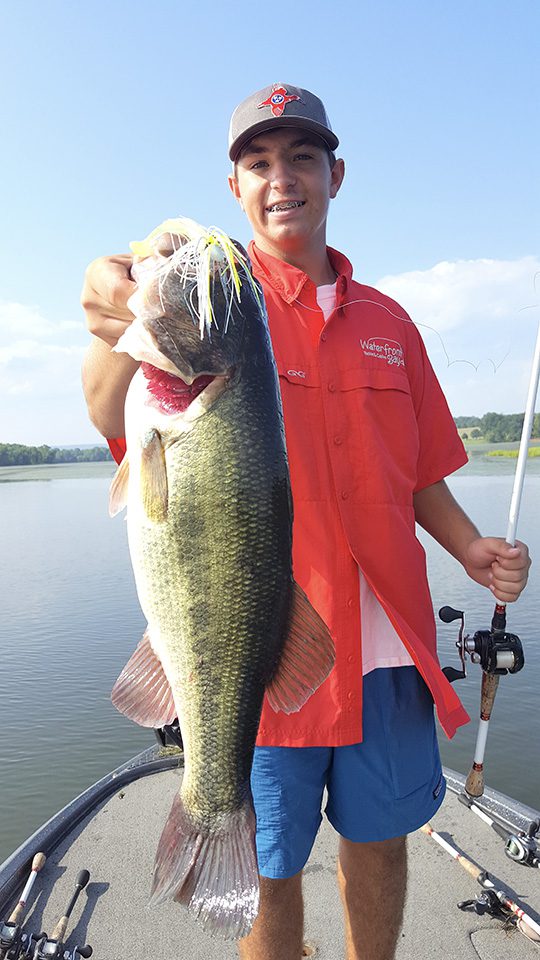By Capt. Jake Davis
The heat of the summer is upon us. Here are some helpful hints to make your time on the water a little more enjoyable and safe. First and foremost are your health and safety. Every year we hear of boating accidents and drownings all over the country. I have learned a valuable lesson this past month; dehydration can cause anglers great pain and health issues. Trust me on this one folks, as I just experienced it myself in the form of kidney stones. Health problems, due to long days on the water, and accidents can be prevented by observing some simple guidelines.
- Drink plenty of water whether you are on the lake during the day or night. Side effects of sodas, coffee, adult beverages and energy drinks can cause dehydration.
- Use sunscreen and/or wear UV rated clothing.
- Never just jump into the lake to cool off. Sure, the surface temperature may be 90 degrees, however, the subsurface temperature can be drastically lower causing a shock to your body. If you’re going to get in, ease your way in the first time, gradually allowing your body to adjust.
- That little white light that came with your boat is called an “All Around Light or Anchor Light.” When fishing at night, keep it on even if you’re next to the bank or anchored. Not only may this little white light save your life, but it’s the law in every state on every body of water.
Now, let’s look at some tactics I use regularly to help clients catch summertime largemouth and smallmouth. Locating fish during the summer can be a task. I start my search around points, grass lines, offshore structure and ledges. The primary lineup is hard-body topwater baits, spinnerbaits, 8- to 12-inch worms, football head jigs and crankbaits.
Is there anything more exciting than the explosion of a giant fish on a Rapala, Pop-R or a Heddon Spook early in the morning or late evening? I think not! Working topwater lures along grass lines or rock points can produce good numbers of fish and good quality of fish as well. When employing them at night, be sure to pause the lure every few feet allowing the fish to locate and target the lure.
During the day, my primary search baits are crankbaits around deep grass lines and ledges. My favorite cranks for covering deep water are Profound Outdoors Z-Boss 20 or Rapala DT 16 (12-16 foot) and DT 20 that dives to 16-20 feet. Color selection really depends upon water clarity and sunlight penetration. If the water is stained or there is little sunlight because of heavy cloud cover, I’ll opt for more chartreuse in my crankbaits. At night I’ll use a black or blue crankbait. When employing deep-diving crankbaits, it is imperative to have the proper rod and reel setup. I use Duckett White Ice Cranking Rod, 7’11” medium-heavy action armed with a 5.4-1 LEW’s reel with 8- to 12-pound-test Vicious Ultimate or Pro Elite fluorocarbon.
Both largemouth and smallmouth often go feeding right after dark in summer, especially on full-moon nights, and will react vigorously to a 1/2- to 1-ounce heavy-vibration, big-profile, dark-colored spinnerbait. Black/red or black/blue with a single #6 Colorado or Indiana blade will get the job done. Cast the spinnerbait along the edges of grass beds and over rocky points, humps and ledges with a Duckett Fishing medium-heavy rod and 14- to 17-pound Vicious Ultimate mono. Let the bait helicopter to the bottom on a tight line with the rod tip held high. When the spinnerbait touches down, drop the rod tip and take up the slack. Most simply “slow roll” the bait, but you should also try to rip the bait up 3 to 6 feet, and let it helicopter back to the bottom.
When the fish are stuck to the bottom day or night, a football head jig is the go-to setup. I prefer a 1/2- or 3/4-ounce Tightline football head matched to a Missile Baits Twin Turbo Tail or D-Bomb when they want a bulked-up profile. Make some changes to your jig. First, trim the weed guard down to 2 or 4 strands. When picking a trailer, use a contrasting color. For example, if your jig is black and blue, use a green pumpkin trailer. I have found a slow retrieve with a shake or twitch of the rod tip on the bottom to be best. This will best imitate a crawfish moving across the bottom. When fishing an area that has current, fish the jig with the flow, in other words, make your cast upstream. Another excellent go-to tactic is a Texas rigged plastic such as an 8.75-inch Tomahawk Worm or creature bait like the D-Bomb. Both of these plastics will move lots of water during a slow presentation. My Texas rig is made up of a 3/8- to ¾-ounce tungsten weight followed by a bead and 4/0 hook. I recommend a 7′ to 7’6″ heavy action Micro Magic Pro or White Ice rod from Duckett Fishing paired with a LEW’s 7:1 reel with either Vicious Ultimate or Pro Elite fluorocarbon in 15- to 17-pound test. It’s simple; you want a rod that provides the longest cast with the sensitivity to feel the lightest strike along with the power and leverage to set the hook. Stay safe, my friends, and “Let’s Go Fishin’!”
See more from Capt. Jake Davis at www.midsouthbassguide.com.
